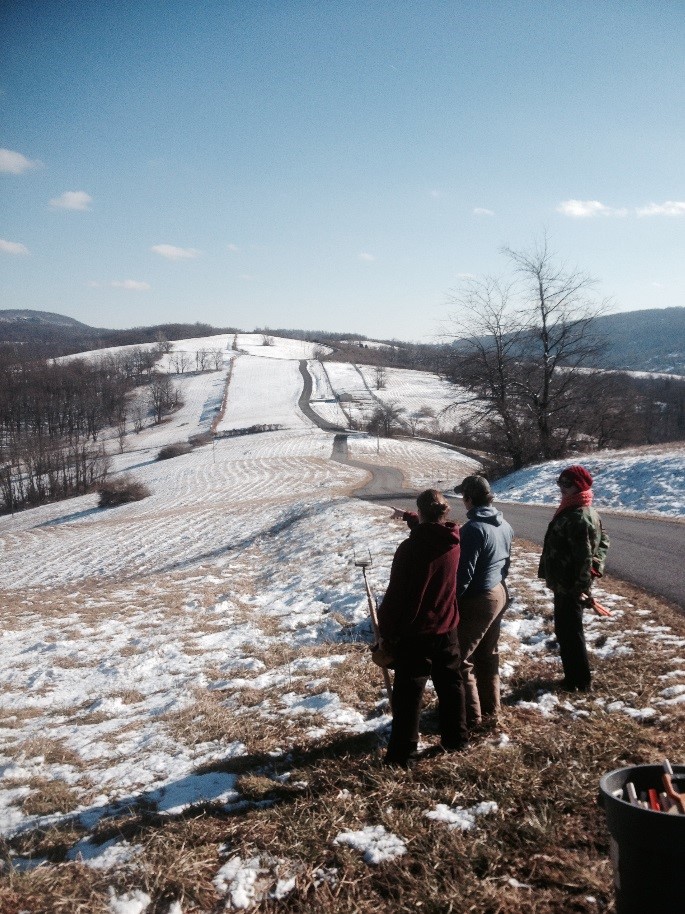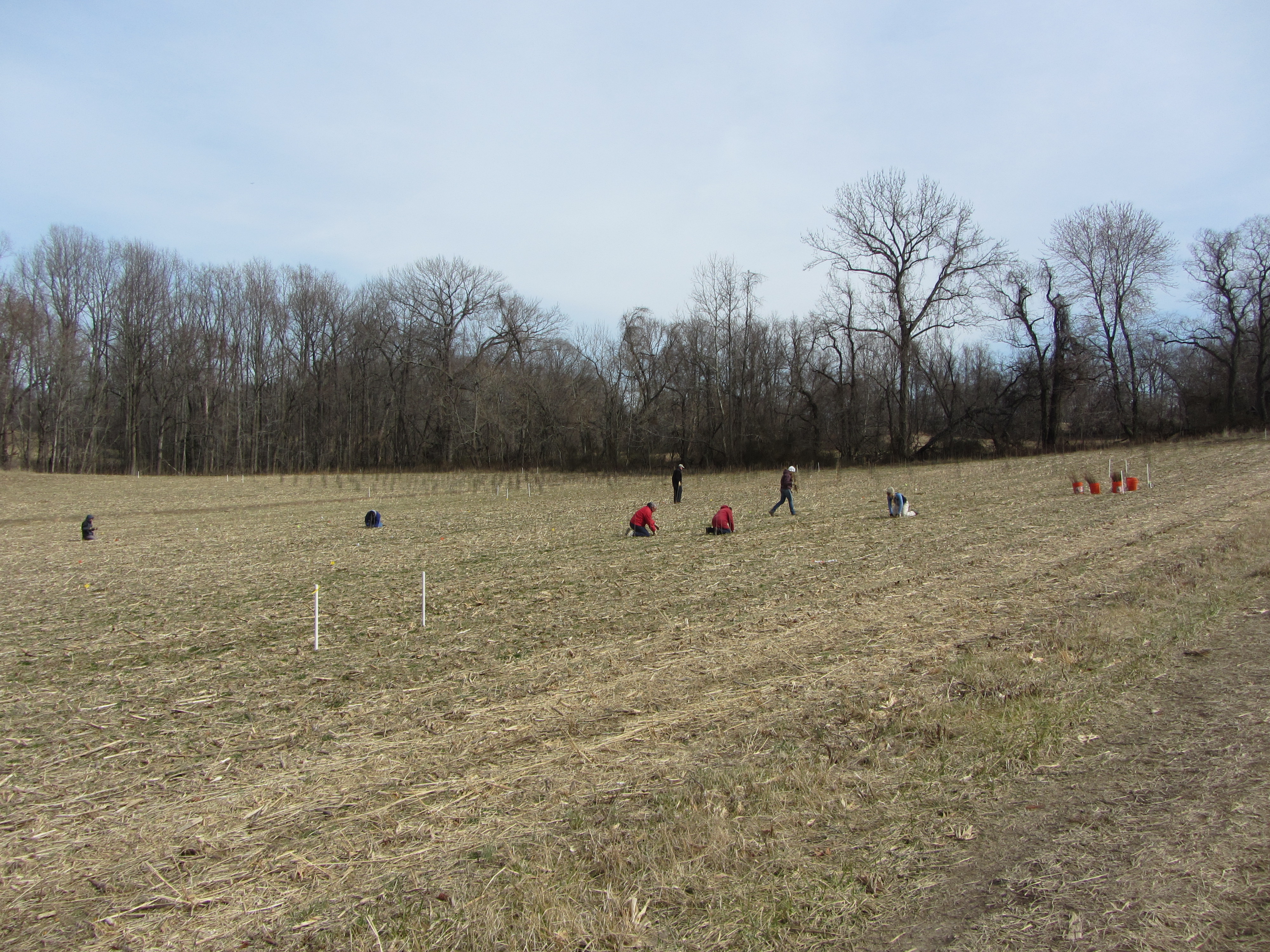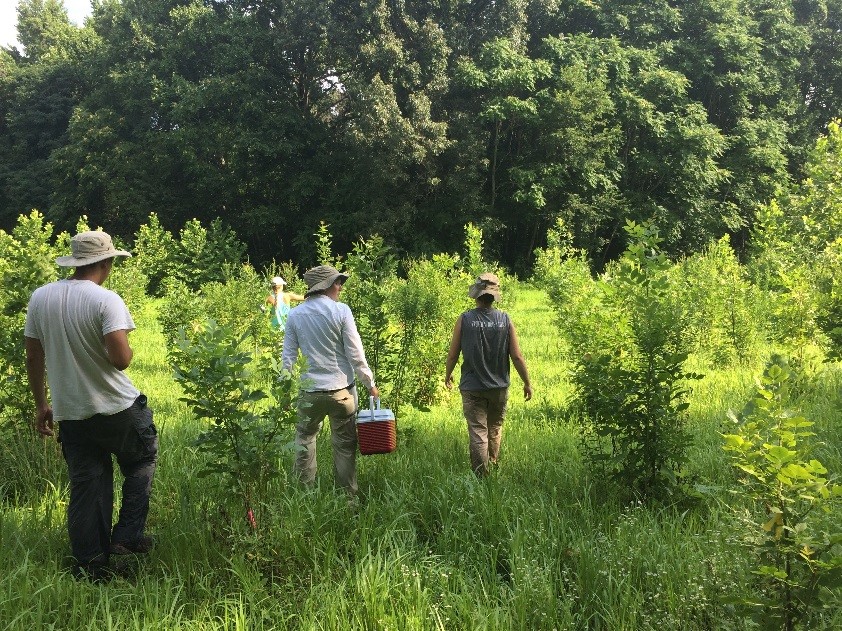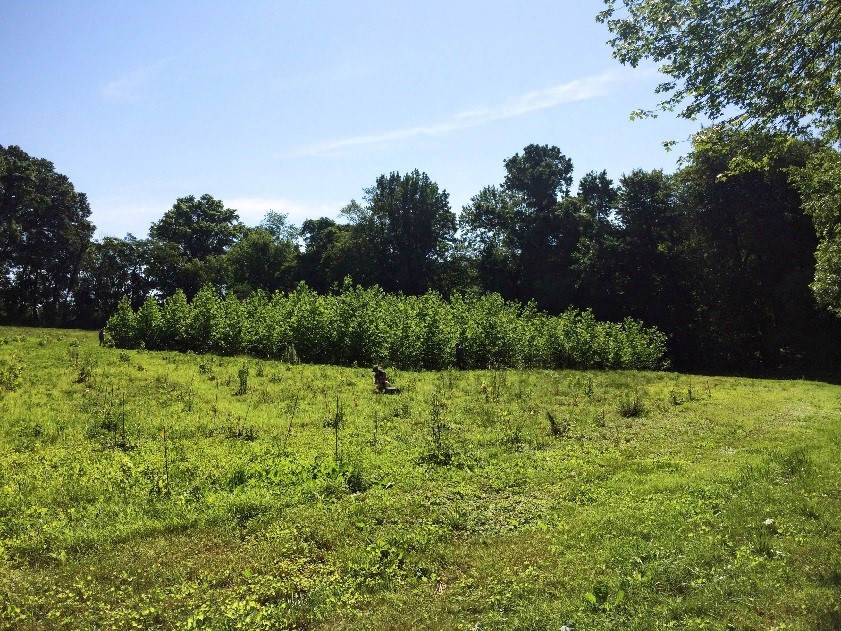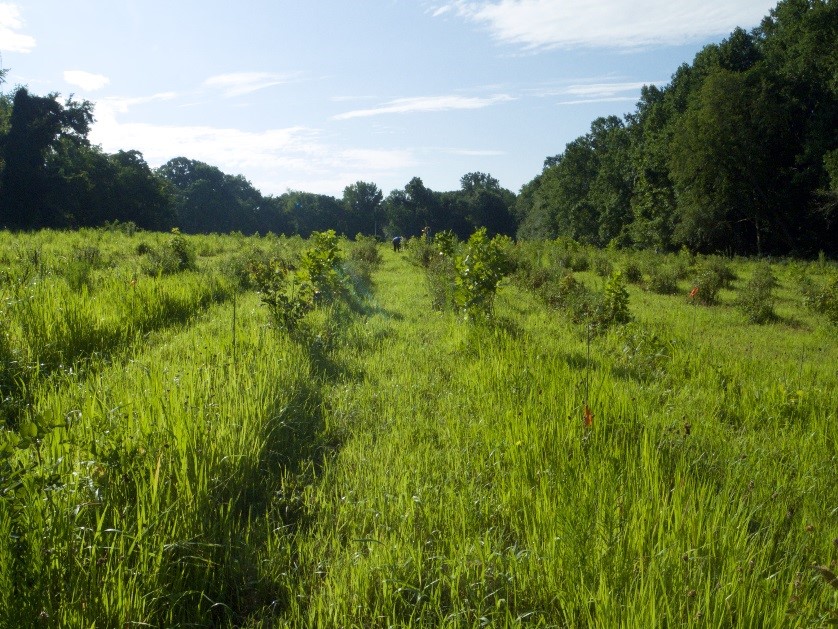BiodiversiTREE (US)
The BiodiversiTREE experiment consists of two sites. BiodiversiTREE@SERC was established close to Edgewater (Maryland) in 2013; BiodiversiTREE@SCBI was established near Front Royal (Virginia) in 2014. The goal of the experiment is examining how diversity both within and among tree species influences local and landscape level processes, including above and belowground productivity, soil nutrient retention, soil carbon turnover, resistance to herbivory, and water quality. Most of the BiodiversiTREE@SERC site is a self-contained watershed that has been intensively studied by Smithsonian scientists for over 30 years. The BiodiversiTREE@SCBI site is located on former pasture fields with minimal management.
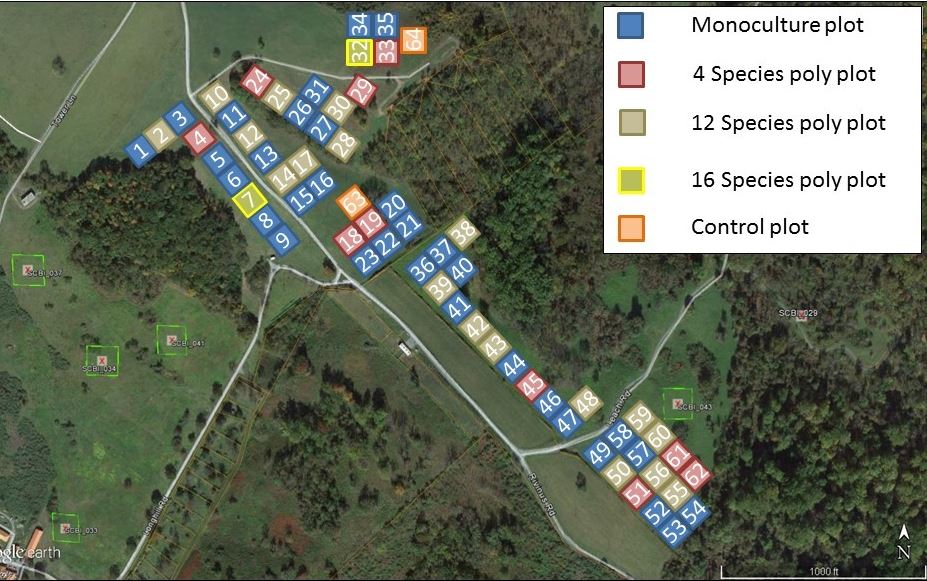
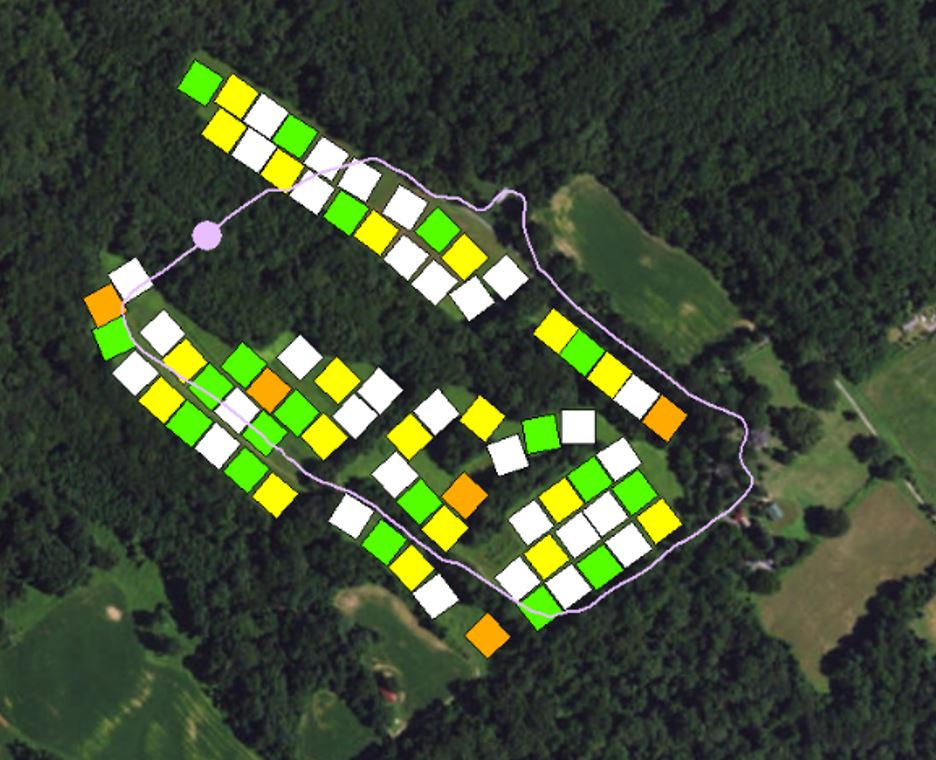
Squares depict experimental plots and are drawn to scale. Right: monocultures (white), 4-species plots (yellow), 12-species plots (green), natural regeneration control plots (orange), watershed WS109 and its water-sampling weir (purple)
Design
Both sites are set up using a classic diversity-ecosystem function manipulation design with 16 tree species. The pool of species includes 14 canopy and 2 sub-canopy tree species, coming from the top 20 species by basal area in local forests. Our experimental richness range of 12 or 16 species spans the natural gradient of species diversity found in local forests.
BiodiversiTREE-SCBI
Monoculture plots (n = 2 per species), 4-species plots (n = 10), 12-species plots (n = 18), or 16-species plots (n = 2) are included. Per plot, 145 trees were planted in a square grid with 2 m between the trees and alternating 8 and 9 trees per row. Two plots of the total 64 plots are used as control plots having no tree species planted. To account for edge effects, each plot has a buffer strip of 97 trees in a 2 m band. Tree placement in the poly plots were randomly assigned. Each tree species was ordered from Virginia Department of Forestry’s state nursery in Crimora, Virginia, Cold Stream Farms in Michigan, North Carolina Forestry Service nursery, or Lawyer Nursery in Montana. By forming a strong partnership with the local state forester, an agreement with Virginia Department of Forestry supplied a majority of the trees to start the project. Bare root seedlings (6-18’‘) were chosen to give the best chance of survival and increase success. Seedlings were kept in cold storage until planting began. A 2.5 meter tall fence was also constructed to prevent deer damage during the juvenile trees’ life. Gates were incorporated to allow access and maintenance inside the plots. Initial soil samples were taken throughout the plots to determine soil variance.
BiodiversiTREE-SERC
Monoculture plots (n = 2 per species), 4-species plots (n = 19), or 12-species plots (n = 19) are present. Per plot, 255 trees were planted in a hexagonal grid with 2.4 m between the trees. To account for edge effects, each plot has a buffer strip of 112 trees in a 2.4 m band that will not be sampled. The 4-species plots are arranged on a gradient of all arbuscular mycorrhizal species to all ectomycorrhizal species. Thus, the plots have the same species richness and density, but varying levels of functional diversity. For each species, we used seed sources from both mid-Atlantic populations (similar in latitude to the experimental location), and more southern populations (Florida and Georgia, two USDA growing bands to the south). Each provenance is represented equally in each plot in which the species grows.
Site characteristics
| BiodiversiTREE (Edgewater) | BiodiversiTREE (Front Royal) | |
|---|---|---|
| Country | USA | USA |
| Local name | SERC | SCBI |
| Biome | temperate | temperate |
| Latitude | 38.867829 | 38.867151 |
| Longitude | -76.551002 | -76.550131 |
| Soil type | loamy fluviomarine deposits | Myersville and Montalto, stony |
| Former land use | corn agriculture since 1978 | abandoned low-input fields |
| Altitude | 7-28 m | 315-389 m |
| Design | hexagonal grid | stem-wise randomisation |
| Plot shape | square | square |
| Plot size (m^2) | 1125 m² | 1126 m² |
| Plant distance (m) | 2.4 | 2 |
| Number of trees planted | 17 850 | 10 000 |
| Planting date | April 2013 | April 2014 |
| Diversity variables | species richness functional diversity geographic origin |
species richness functional diversity evenness |
| Diversity gradient | 1, 4, 12 sp. AM or EM fungi northern vs. southern |
1, 4, 12, 16 sp. AM or EM fungi understorey vs. canopy |
| Size species pool | 16 | 16 |
| Species pool | Acer rubrum Carpinus caroliniana Carya alba Carya glabra Cornus florida Fagus grandifolia Fraxinus pennsylvanica Liriodendron tulipifera Liquidambar styraciflua Nyssa sylvatica Platanus occidentalis Quercus alba Quercus falcata Quercus rubra Quercus velutina Ulmus americana |
Acer rubrum Carya glabra Castanea dentate Celtis occidentalis Corylus americana Diospyros virginiana Fagus grandifolia Fraxinus pennsylvanica Liriodendron tulipifera Platanus occidentalis Prunus serotina Quercus alba Quercus prinus Quercus rubra Quercus velutina Tilia americana |
| Contact person | John D. Parker | William McShea |
| parkerj@si.edu | McSheaW@si.edu |
Research
The four fundamental research questions that will be investigated are: (1) Does tree species diversity affect forest productivity and ecosystem function? (2) Is functional diversity important? (3) How will species and population sources respond to climate change? (4) How does tree diversity impact water quality and quantity? Phase I of the experiment replanted 13 hectares of a self-contained watershed that have been in continuous corn agriculture since 1978, with a similarly long period of monitoring water quantity/quality from an instrumented weir (WS109). In addition, corn is a C4 plant with a different isotopic carbon signature than C3 trees. Thus, we will examine how reforestation affects watershed quality and track changes in soil carbon isotopes through time to estimate the quantity, turnover, and movement of carbon in the soil as the land returns to forest.
Extra information
For more information on the BiodiversiTREE experiment, send an e-mail to the contact persons, or explore the publications that utilized data from this experiment.
Research papers
- Augusto L, Borelle R, Boča A, Bon L, Orazio C, Arias-González A, Bakker MR, Gartzia-Bengoetxea H, Bernier AF, Cantero A, Cavender-Bares J, Correia AH, De Schrijver A, Diez-Casero JJ, Eisenhauer N, Fotelli MN, Gâteblé G, Godbold DL, Gomes-Caetano-Ferreira, Gundale MJ, Jactel H, Koricheva J, Larsson M, Laudicina VA, Legout A, Martín-García J, Mason WL, Meredieu C, Mereu S, Montgomery RA, Musch B, Muys B, Paillassa E, Paquette A, Parker JD, Parker WC, Ponette Q, Reynolds C, Rozados-Lorenzo MJ, Ruiz-Peinado R, Santesteban-Insausti X, Scherer-Lorenzen M, Silva-Pando FJ, Smolander A, Spyroglou G, Teixeira-Barcelos EB, Vanguelova EI, Verheyen K, Vesterdal L, Charru M 2025 Widespread slow growth of acquisitive tree species. Nature 640: 395–401 - doi: 10.1038/s41586-025-08692-x
- Blondeel H, Guillemot J, Martin‐StPaul N, Druel A, Bilodeau‐Gauthier S, Bauhus J, … Baeten L 2024 Tree diversity reduces variability in sapling survival under drought. Journal of Ecology 112(5): 1164-1180 - https://doi.org/10.1111/1365-2745.14294
- Luo S, Schmid B, Hector A, Scherer‐Lorenzen M, Verheyen K, Barsoum N, Bauhus J, Beyer F, Bruelheide H, Ferlian O, Godbold D, Hall JS, Hajek P, Huang Y, Hölscher D, Kreft H, Liu X, Messier C, Nock C, Paquette A, Parker JD, Parker WC, Paterno GB, Reich PB, Rewald B, Sandén H, Sinacore K, Stefanski A, Willams L, Eisenhauer N 2024 Mycorrhizal associations modify tree diversity− productivity relationships across experimental tree plantations. New Phytologist 243:1205-1219 - doi: 10.1111/nph.19889
- Vázquez-González C, Castagneyrol B, Muiruri EW, Barbaro L, Abdala-Roberts L, Barsoum N, Fründ J, Glynn C, Jactel H, McShea WJ, Mereu S, Mooney KA, Morillas L, Nock CA, Paquette A, Parker JD, Parker, WC, Roales J, Scherer-Lorenzen M, Schuldt A, Verheyen K, Weih M, Yang B, Koricheva J 2024 Tree diversity enhances predation by birds but not by arthropods across climate gradients. Ecology Letters (27): e14427 - https://doi.org/10.1111/ele.14427
- Zheng L, Barry KE, Guerrero-Ramírez NR, Craven D, Reich PB, Verheyen K, … Hautier Y 2024 Effects of plant diversity on productivity strengthen over time due to trait-dependent shifts in species overyielding. Nature communications 15(1): 2078 - https://doi.org/10.1038/s41467-024-46355-z
- Depauw L, De Lombaerde E, Dhiedt E, Blondeel H, Abdala-Roberts L, Auge H, Barsoum N, Bauhus J, Chu C, Damtew A, Eisenhauer N, V. Fagundes M, Ganade G, Gendreau-Berthiaume B, Godbold D, Gravel D, Guillemot J, Hajek P, Hector A, Hérault B, Jactel H, Koricheva J, Kreft H, Liu X, Mereu S, Messier C, Muys B, Nock CA, Paquette A, Parker JD, Parker WC, Paterno, GB, Perring MP, Ponette Q, Potvin C, Reich PB, Rewald B, Scherer-Lorenzen M, Schnabel F, Sousa-Silva R, Weih M, Clara Zemp D, Verheyen K, Baeten L 2024 Enhancing Tree Performance Through Species Mixing: Review of a Quarter-Century of TreeDivNet Experiments Reveals Research Gaps and Practical Insights. Current Forestry Reports - https://doi.org/10.1007/s40725-023-00208-y
- Butz EM, Schmitt LM, Parker JD, Burghardt KT 2023 Positive tree diversity effects on arboreal spider abundance are tied to canopy cover in a forest experiment. Ecology 104(8): e4116 - doi: 10.1002/ecy.4116
- King RA, Pullen J, Cook-Patton SC, Parker JD 2023 Diversity stabilizes but does not increase sapling survival in a tree diversity experiment. Restoration Ecology 7(5): e13927 - doi: 10.1111/rec.13927
- FAO 2023 Towards more resilient and diverse planted forests. Unasylva (254)74: 2031/1. Rome. https://doi. org/10.4060/cc8584en
- Davrinch A, Haider 2021 Intra-specific leaf trait responses to species richness at two different local scales. Basic and Applied Ecology 55: 20-32 - https://doi.org/10.1016/j.baae.2021.04.011
- Guo P, Wang M, Orr M, Li Y, Chen J, Zhou Q, Staab M, Fornoff F, Chen G, Zhang N, Klein A-M, Zhu C 2021 Tree diversity promotes predatory wasps and parasitoids but not pollinator bees in a subtropical experimental forest. Basic and Applied Ecology 53:134-142 - https://doi.org/10.1016/j.baae.2021.03.007
- Messier C, Bauhus J, Sousa-Silva R, Auge H, Baeten L, Barsoum N, Bruelheide H, Caldwell B, Cavender-Bares J, Dhiedt E, Eisenhauer N, Ganade G, Gravel D, Guillemot J, Hall JS, Hector A, Hérault B, Jactel H, Koricheva J, Kreft H, Mereu S, Muys B, Nock CA, Paquette A, Parker JD, Perring MP, Ponette Q, Potvin C, Reich PB, Scherer-Lorenzen M, Schnabel F, Verheyen K, Weih M, Wollni M, Zemp DC 2021 For the sake of resilience and multifunctionality, let’s diversify planted forests! Conservation Letters e12829 - https://doi.org/10.1111/conl.12829
- Devaney JL, Pullen J, Cook‐Patton SC, Burghardt KT, Parker JD 2020 Tree diversity promotes growth of late successional species despite increasing deer damage in a restored forest. Ecology 101(8) e03063 - https://doi.org/10.1002/ecy.3063
- Griffin EA, Harrison JG, McCormick MK, Burghardt KT, Parker JD 2019 Tree diversity reduces fungal endophyte richness and diversity in a large-scale temperate forest experiment. Diversity 11(12) 234 - https://doi.org/10.3390/d11120234
